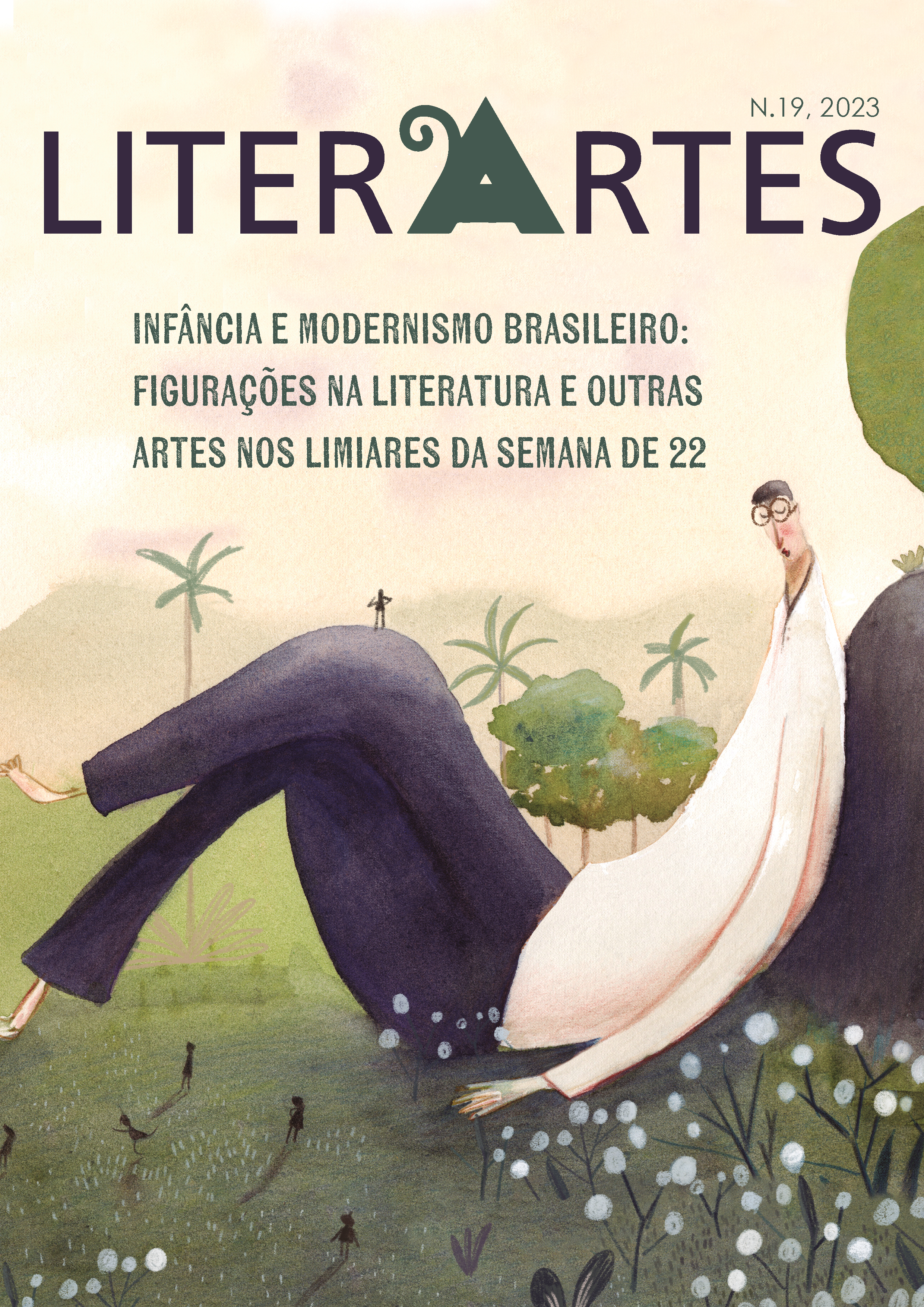Clarice Lispector's girls and the translation of childhood in her works
DOI:
https://doi.org/10.11606/issn.2316-9826.literartes.2023.212007Keywords:
Clarice Lispector, child protagonists, girls, familyAbstract
The article aims to present the female characters present in Clarice Lispector's texts to understand the childhood of girls in the 1920s - 1980s from the literary and historical perspective of Brazil in that period. The methodology used for the research was a review of literary texts where the protagonists are girls between eight and ten years old, located in Recife, the city where the writer lived during her childhood. For a deeper understanding of Lispector's literary construction, some theorists are considered as Alberto Manguel (2016), Maurice Blanchot (1969), Giorgio Agamben (2005, 2007, 2017). Georges Bataille (2016) and Judith Butler (2017) contribute to a philosophical understanding of self-writing and the importance of recovering memory, while Philippe Ariès (1973) makes some historical observations about the context of the time. The article results in an overview of how the girls, mainly Clarice Lispector herself, wanted their life as autonomous, independent individuals, but with the remorse of the social responsibility that imposed on girls and women a pattern of behavior that had distressed them since the end of childhood and early puberty, subjecting them to the imposed patriarchal and conservative system.
References
AGAMBEN, Giorgio. A comunidade que vem. Belo Horizonte: Editora Autêntica, 2017. Tradução Cláudio Oliveira.
AGAMBEN, Giorgio. Infância e história: destruição da experiência e origem da história. Belo Horizonte: Editora UFMG, 2005. Tradução de Henrique Burigo.
AGAMBEN, Giorgio. Profanações. São Paulo: Editora Boitempo, 2007. Tradução de Selvino José Assmann.
AIRÈS, Philippe. História social da criança e da família. Tradução de Dora Flaksman. Rio de Janeiro: Editora Guanabara, 1978.
BATAILLE, George. A experiência interior: seguida de Método e Postcriptum 1953. Tradução Fernando Scheibe. Belo Horizonte: Editora Autêntica, 2016.
BLANCHOT, Maurice. O espaço literário. Rio de Janeiro: Rocco, 1987.
BORELLI, Olga. Clarice Lispector: Esboço de um possível retrato. Rio de Janeiro: Editora Nova Fronteira, 1981.
BUTLER, Judith. Relatar a si mesmo: Crítica da violência ética. Tradução Rogério Bettoni. Belo Horizonte: Editora Autêntica, 2017.
CURY, Maria Zilda Ferreira. “Memórias da imigração”. In Palavra e Imagem, memória e escritura. (Org.) Márcio Seligmann-Silva (Org.). Chapecó: Edirora Argos, 2006.
GOTLIB, Nádia Battella. Clarice: Uma vida que se conta. São Paulo: Ática, 1995.
KONDER, Leandro. O espírito poético da educação. In: NEVES, Margarida de Souza;
LÔBO, Yolanda Lima; MIGNOT, Ana Chrystina Venancio. Cecília Meirelles: A poética da educação. Rio de Janeiro: Editora Loyola, 2001.
KRISTEVA, Julia. O Gênio Feminino: A vida, a loucura, as palavras. Tomo I Hannah Arendt. Tradução Eduardo Francisco Alves. Rio de Janeiro: Editora Rocco, 2002.
LISPECTOR, Clarice. Felicidade Clandestina. Rio de Janeiro: Editora Rocco, 1998.
MANGUEL, Alberto. Uma história natural da curiosidade. Tradução de Paulo Geiger. São Paulo: Companhia das Letras, 2016.
MOSER, Benjamin. Clarice, uma biografia. Tradução José Geraldo Couto. São Paulo: Cosaf Naify, 2009.
Downloads
Published
Issue
Section
License
Copyright (c) 2023 Rosangela Fernandes Eleutério

This work is licensed under a Creative Commons Attribution-NonCommercial 4.0 International License.
Autores que publicam nesta revista concordam com os seguintes termos:
- Autores mantém os direitos autorais e concedem à revista o direito de primeira publicação, com o trabalho simultaneamente licenciado sob a Licença Creative Commons Attribution que permite o compartilhamento do trabalho com reconhecimento da autoria e publicação inicial nesta revista.
- Autores têm autorização para assumir contratos adicionais separadamente, para distribuição não-exclusiva da versão do trabalho publicada nesta revista (ex.: publicar em repositório institucional ou como capítulo de livro), com reconhecimento de autoria e publicação inicial nesta revista.
- Autores têm permissão e são estimulados a publicar e distribuir seu trabalho online (ex.: em repositórios institucionais ou na sua página pessoal) a qualquer ponto antes ou durante o processo editorial, já que isso pode gerar alterações produtivas, bem como aumentar o impacto e a citação do trabalho publicado (Veja O Efeito do Acesso Livre).



